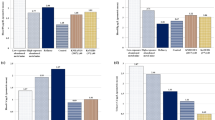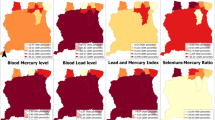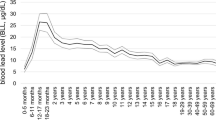Abstract
Aims:
In Slovenia, there were no data available for an assessment of cadmium and lead levels in the population till 2001. The present study was conducted to evaluate the cadmium and lead burden from all sources (air, food, water) with the aim of obtaining initial information on cadmium and lead levels in blood of healthy and occupationally unexposed young males. Methods: There were 464 participants included in the analysis of blood cadmium and lead levels, aged between 18 and 27 years, the median age being 20 years. Blood samples of maximum 2 ml were taken from the cubital vein for analysis of cadmium and lead levels. Results: There were 463 blood samples analyzed for cadmium and 464 for lead. Of all tested persons, 38.2% had less than 0.5 μg/l of cadmium in their blood and 28.2% up to 1 μg/l. The median level of blood cadmium was 0.5 μg/l. The percentage of recruits with blood lead level over 100 μg was 3.1%. The median level of blood lead was 35 μg/l. The differences in blood levels of both pollutants were statistically significant with regard to the region of permanent residence (P<0.001). Conclusions: The results of the study give a good assessment of cadmium and lead burdening of young Slovene male population. The information obtained provides a foundation for further comparative research at the international level as well as for further study and risk assessment of individual population groups exposed to greater risk due to their lifestyle and eating habits.
This is a preview of subscription content, access via your institution
Access options
Subscribe to this journal
Receive 6 print issues and online access
$259.00 per year
only $43.17 per issue
Buy this article
- Purchase on Springer Link
- Instant access to full article PDF
Prices may be subject to local taxes which are calculated during checkout





Similar content being viewed by others
References
Altman D.G. Practical Statistics for Medical Research. Chapman & Hall, London, 1993 p. 439.
Brockhaus A., Collet W., and Dolgner R. Exposure to lead and cadmium of children living in different areas of North-West Germany: results of biological monitoring studies. Int Arch Occup Environ Health 1988: 60: 211–222.
Chia S.E., Chan O.Y., Sam C.T., and Eng B.H. Blood cadmium levels in non-occupationally exposed adult subjects in Singapore. Sci Total Environ 1994: 145: 119–123.
Dewailly E., Ayotte P., Bruneau S., Lebel G., Levallois P., and Weber J.P. Exposure of the Inuit Population of Nunavik (Arctic Quebec) to lead and mercury. Arch Environ Health 2001: 56: 350–357.
Elinder C.G. Biological monitoring of cadmium, In: Dillon H.K., and Ho M.H. (Eds.). Biological Monitoring of Exposure to Chemicals: Metals. Wiley Publishers, New York, 1991 pp. 197–207.
Eržen I., Škapin K., and Štupar J. Cadmium and lead levels in blood and hair samples of blood-donor population. Preventive Medicine Group, National Institute of Public Health, Portorož, 2001 pp. 29–34 (in Slovene).
Galal Gorchev H. Dietary intake, levels in food and estimated intake of lead, cadmium, and mercury. Food Add Contaminants 1993: 10: 115–128.
GEMS/Food-EURO. Reliable evaluation of low-level contamination in food, WHO, Copenhagen, 1995 pp. 1–20.
Gulson B.L., Mahaffey K.R., Jameson W.C., Patison N., Law A.J., Mizon K.J., Korsch M.J., and Pederson D. Impact of diet on lead in blood and urine in female adults and relevance to mobilization of lead from bone stores. Environ Health Persp 1999: 107: 257–263.
Hallien I.P., Jorhem L., Lagerkvist B.J., and Oskarsson A. Lead and cadmium levels in human milk and blood. Sci Total Environ 1995: 166: 149–155.
Lippmann M. Lead and human health: background and recent findings. Environ Res 1990: 51: 1–24.
Louekari K., Uusitalo U., and Pietinen P. Variation and modifying factors of the exposure to lead and cadmium based on an epidemiological study. The Sci Total Environ 1989: 84: 1–12.
Minoia C. Analytical and extra-analytical problems connected with the determination of lead and cadmium in the blood. Ann Int Super Sanita 1985: 1: 61–71.
Moon C.S., Zhang Z.W., Shimbo S., Watanabe T., Moon D.H., Lee C.U., Ahn K.D., Lee S.E., and Ikeda M. Dietary intake of cadmium and lead among the general population in Korea. Environ Res 1995: 71: 46–54.
Moore M.R., Robertson S.J., Gilmour W.H., Murray G.D., Britton A., Low R.A., and Watt G.C. Decline of maternal blood lead concentrations in Glasgow. J Epidemiol Commun Health 1998: 52: 672–673.
Nordberg G., and Nordberg M. Biological monitoring of cadmium, In: Clarkson T.W. (Ed.). Biological Monitoring of Toxic Metals. Plenum Press, New York, London, 1988 pp. 151–168.
Shaham J., Meltzer A., and Ashkenazi R. Biological monitoring of exposure to cadmium, a human carcinogen, as a result of active and passive smoking. J Occup Environ Med 1996: 38: 1220–1228.
Siegel S., and Castellan N.J. Nonparametric Statistics for the Behavioral Sciences. McGraw-Hill Book Company, New York, 1988 p. 399.
Staessen J., Yeoman W.B., Fletcher A.E., Markowe H.L., Marmont M.G., Rose G., Semmence A., Shipley M.J., and Bulpitt C.J. Blood cadmium in London civil servants. Int J Epidemiol 1990: 19: 362–366.
Watanabe T., Nakatsuaka H., Shimbo S., Iwami O., Imai Y., Moon C.S., Zhang Z.W., Iguchi H., and Ikeda M. Reduced cadmium and lead burden in Japan in past 10 years. Int Arch Occup Environ Health 1996: 68: 305–314.
Weyermann M., and Brenner H. Alcohol consumption and smoking habits as determinants of blood lead levels in a national population sample from Germany. Arch Environ Health 1997: 52: 233–239.
World Health Organisation Regional publications. Lead. In Air quality guidelines. European Publications Series, Vol. 23. WHO, Copenhagen, 1987 pp. 242–261.
World Health Organisation. Human Exposure Assessment. WHO, Geneva, 2000 pp. 34–69.
Xu B., Chia S.E., and Ong C.N. Concentrations of cadmium, lead, selenium and zinc in human blood and seminal plasma. Biol Trace Elem Res 1994: 40: 49–57.
Acknowledgements
We thank all the participants and especially Ksenja Bošnjak, Jožica Žibret and Mateja Šraml for their contributions to this research. Helpful comments and support from Dražigost Pokorn are also acknowledged with gratitude.
This research was financially supported by the Ministry of Health of Slovenia and Institute of Public Health Celje.
Author information
Authors and Affiliations
Corresponding author
Rights and permissions
About this article
Cite this article
Eržen, I., Zaletel Kragelj, L. Exposure assessment of male recruits in Slovenia to cadmium and lead due to biological monitoring. J Expo Sci Environ Epidemiol 14, 385–390 (2004). https://doi.org/10.1038/sj.jea.7500335
Received:
Accepted:
Published:
Issue Date:
DOI: https://doi.org/10.1038/sj.jea.7500335



